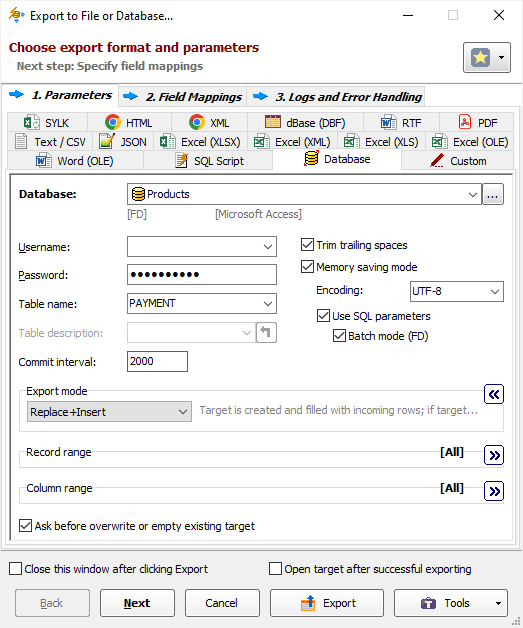Here you can find the detailed instruction on how to export data from any database to Microsoft Access database in Exportizer software.
Below, it is shown how to export data from GUI or command line.
Export Conditions
In most cases, to export data to Access database, it is important to fulfill the following conditions:
- If source and target databases are configured as ODBC DSNs, Exportizer Pro can be used, otherwise Exportizer Enterprise should be used.
- When using ODBC either on the source or the target side, make sure the Exportizer and the corresponding ODBC driver(s) have the same architecture too.
Note: If your operating system is 64-bit, you can install both 32-bit and 64-bit versions of the Exportizer software and use them independently.
Export Steps (GUI)
- Launch Exportizer.
- Register and open your source database.
- Choose a dataset or datasets to export:
- select a table from the table list;
or - open an SQL window, then write and execute an SQL query;
or - select multiple tables in the table list; before doing that, click Select Tables button
 ;
;
or - prepare a mix of multiple tables and/or SQL queries: open multiple tables one by one and multiple SQL windows; in SQL windows, write your database queries and execute them to get the result sets.
Please note that exporting multiple datasets at a time is available in Exportizer Enterprise only.
- select a table from the table list;
- Click Export button
 or choose a needed item from Export menu.
or choose a needed item from Export menu. - Switch to the Database tab. Select your registered Access database as a target database and set out specific export options. If you did not register it yet, do it now by clicking the '...' button to the right; you can also create a new Access database here. Some important notes:
- Turn on the Memory saving mode option and its related options. In case of exporting problems, if you suspect that they can be caused by these options, try different combinations of them. If exported data or column names on any side can contain Unicode characters, set the corresponding stream Encoding, e.g. UTF-8.
- Choose the Export mode. To learn about all possible modes, read detailed description for Database export format. For multi-table exporting, this mode will be applied to the most of the tables, and you can override it for specific tables at the next step. For example, it can be Replace+Insert for the most of tables, and Update or Append for others etc.
- If you are exporting a single dataset, specify the target Table name. For multi-table exporting, leave the Table name field empty; otherwise, the data will be exported to one destination table.
- The bigger Commit interval value, the faster your exporting process. But too big value may cause memory and other issues. Therefore, try to play with it to find the optimal value before porting the solution to your production environment.

- Click Next. Specify the source-to-target mappings.
When you are exporting one dataset, you set the correspondence between the source and target fields/columns and specify target columns attributes.
For multi-table exporting, you specify the correspondence between the source datasets and target tables with optional editing nested field mappings and some other options like export mode.
- Click Export.
Exporting Data to Access from Command Line
In the documentation, you can find full Exportizer command line specification. But basic command lines can be built in Exportizer GUI automatically by clicking Build Command Line button. In Export dialog, you can also create an action file using Tools button. Below, a set of command line and action file examples of exporting data to MS Access is listed.
Export to Access Command Line Examples
- Exporting a Paradox table to existing Access database:
"C:\Program Files (x86)\Vitaliy Levchenko\Exportizer Enterprise 10\exptizer.exe" /export /ExportType=DATABASE /ExportMode=REPLACE+INSERT /IncludeMemo /MemorySaving /UseSQLParameters /UseBatchMode /Encoding=UTF-8 /SrcDB=C:\OldDB\MyTable.db /TrgDBInterface=FD /TrgDBKind=FILE /TrgDBDriver=Access /TrgDB=C:\NewDB\Products.mdb /TrgTableName=clothes - The same as above, but in silent mode and using a log file:
"C:\Program Files (x86)\Vitaliy Levchenko\Exportizer Enterprise 10\exptizer.exe" /silent /export /ExportType=DATABASE /ExportMode=REPLACE+INSERT /IncludeMemo /MemorySaving /UseSQLParameters /UseBatchMode /Encoding=UTF-8 /SrcDB=C:\OldDB\MyTable.db /TrgDBInterface=FD /TrgDBKind=FILE /TrgDBDriver=Access /TrgDB=C:\NewDB\Products.mdb /TrgTableName=clothes /LogFile=C:\Test\export.log - Exporting all Paradox files from a folder to existing Access database in silent mode:
"C:\Program Files (x86)\Vitaliy Levchenko\Exportizer Enterprise 10\exptizer.exe" /silent /export /ExportType=DATABASE /ExportMode=REPLACE+INSERT /IncludeMemo /MemorySaving /UseSQLParameters /UseBatchMode /Encoding=UTF-8 /SrcDB=C:\OldDB\*.db /TrgDBInterface=FD /TrgDBKind=FILE /TrgDBDriver=Access /TrgDB=C:\NewDB\Products.mdb /TrgTableName=* /LogFile=C:\Test\export.log - The same as above, but creating Access database on the fly (if does not exist):
"C:\Program Files (x86)\Vitaliy Levchenko\Exportizer Enterprise 10\exptizer.exe" /silent /export /ExportType=DATABASE /ExportMode=REPLACE+INSERT /IncludeMemo /MemorySaving /UseSQLParameters /UseBatchMode /Encoding=UTF-8 /SrcDB=C:\OldDB\*.db /TrgDBInterface=FD /TrgDBKind=FILE /TrgDBDriver=Access /TrgDB=C:\NewDB\Products.mdb /TrgTableName=* /LogFile=C:\Test\export.log /CreateTargetContainer - Export all tables from SQLite database to Access database, created on the fly (if does not exist):
"C:\Program Files (x86)\Vitaliy Levchenko\Exportizer Enterprise 10\exptizer.exe" /export /ExportType=DATABASE /ExportMode=REPLACE+INSERT /CommitInterval=1000 /MemorySaving /UseSQLParameters /UseBatchMode /Encoding=UTF-8 /TrgTableName=* /TrgDBInterface=FD /TrgDBKind=FILE "/TrgDBDriver=Microsoft Access" /TrgStringFormat=Choose /TrimTrailingSpaces /SrcDBInterface=FD /SrcDBKind=FILE /SrcDBDriver=SQLITE /SrcDB=C:\MyData\TestSQLiteDb.db /SrcSharedCache=True /SrcLockingMode=Exclusive /SrcTableName=* /TrgDB=C:\MyData\NewAccessDB.mdb /CreateTargetContainer
Note: You can add other parameters to the command lines above according to the documentation.
Export to Access Action File Example
The last command line above can be transformed to an action file, which is much more comfortable to work with. You can run action files either form the command line or from Exportizer GUI. The action file contains all the command line parameters (except /silent switch), one parameter per line, and allows comments:
/export
/ExportType=DATABASE
/ExportMode=REPLACE+INSERT
/IncludeMemo
/MemorySaving
/UseSQLParameters
/UseBatchMode
/Encoding=UTF-8
/SrcDB=C:\OldDB\*.db ;Export all Paradox files from the folder
/TrgDBInterface=fd
/TrgDBKind=FILE
/TrgDBDriver=Access
/TrgDB=C:\NewDB\Products.mdb
/TrgTableName=*
/LogFile=C:\Test\export.log
/CreateTargetContainerIf you save the file, for example, as C:\Export\Paradox2Access.txt, then your command line will look like:
"C:\Program Files (x86)\Vitaliy Levchenko\Exportizer Enterprise 10\exptizer.exe" /silent /ActionFile=C:\Export\Paradox2Access.txtSee also



